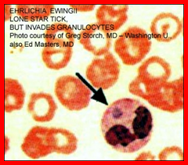
SHARE THIS ARTICLE:
Ehrlichiosis/Anaplasmosis
 Scientists used to separate ehrlichiosis into two entities caused by the bacterium Ehrlichia: Human Monocytic Ehrlichiosis (HME) and Human Granulocytic Ehrlichiosis (HGE). After further study, they determined that HGE is actually caused by a bacterium, Anaplasma phagacytophilum. HME is caused by a bacterium, Ehrlichia chaffeensis.
Scientists used to separate ehrlichiosis into two entities caused by the bacterium Ehrlichia: Human Monocytic Ehrlichiosis (HME) and Human Granulocytic Ehrlichiosis (HGE). After further study, they determined that HGE is actually caused by a bacterium, Anaplasma phagacytophilum. HME is caused by a bacterium, Ehrlichia chaffeensis.
Symptoms of ehrlichiosis/anaplasmosis include: fever, malaise, headaches, chills, severe muscle aches, vomiting, anemia, lung infection, decreased white blood cells and platelets, elevated liver enzymes, seizures, encephalopathy, meningitis, confusion, ataxia and cranial nerve palsy. Co-infection with Lyme can cause more severe symptoms. Death can result.
Treatment is with doxycycline.
Ticks that transmit anaplasmosis include Ixodes scapularis (deer tick or black legged tick) and Ixodes pacificus (western black legged tick).
Ticks that transmit ehrlichiosis (HME) include Amblyomma americanum (lone star) and Dermacentor variabilis (American dog). Ixodes scapularis (deer tick or black legged tick) and Ixodes pacificus (western black legged tick) ticks have been shown to carry the ehrlichiosis bacterium, but to date, transmission is still in question.
©LDA. 2014. 2015. This web site provides practical and useful information on the subject matters covered. It is distributed with the understanding that LDA is not engaged in rendering medical or other professional services. Seek professional services if necessary.





